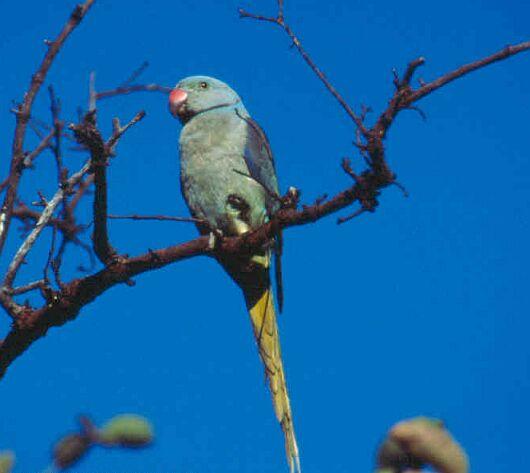Parakeet - Malabar
Bluewinged Parakeet, Blue Winged Parakeet Scientific Name: Psittacula columboides columboides
Fri, 4th July, 2025 - 7:06 am GMT
Sponsor Ads:

Alternative Name
Bluewinged Parakeet, Blue Winged Parakeet Scientific Name: Psittacula columboides columboidesBasic Info
The Malabar Parakeet has beautifully colored plumage. The male is described as follows: its overall color is a bluish-gray with a sometimes reddish-pink tint. One of the things that make this bird so striking is the double ring around the neck of the male. The lower ring is a brilliant light blue, while the top ring is more of a greenish dark gray color. They have green feathers in front of their eyes, which extend towards their beaks. The plumage on their heads is bluer in color than the rest of their bodies, though it gets progressively lighter at the top of the head. Above the nares and on the cheeks the blue color is more distinct. They have a striking bright red beak with a bone colored tip. The female Malabar Parakeets lack the brilliant blue band around their necks. Males generally have a greener casting to the feathers on their foreheads, and female's heads are gray. The bill of the female is black, as opposed to the brilliantly color bill of the male. The average adult Malabar Parakeet measures 38 centimeters (15 inches) in length. Immatures can be distinguished from adults by their orange beaks. They have plumage similar to that of the female, after their first molt they get their adult plumage, and their beaks will change to red for males and black for females.
Health
Recently imported Malabar Parakeets may be particularly vulnerable to disease. Breeding The Malabar Parakeet is not easily bred in captivity. Males are also sometimes aggressive to females. If breeding does occur, the female will lay three to four eggs, which need to incubate for 23 days. Babies will be independent in three weeks. In the wild the breeding season of the Malabar Parakeet begins in January and lasts through March. They generally nest in tall trees, taking over the nests of other birds.Habitat
N/ABehavior
The Malabar Parakeet is fairly uncommon in the pet trade, but it is a beautiful bird. The Malabar Parakeet is a social bird living in small groups composed of four to five individuals. On rare occasions they may be observed in small flocks. They are fairly noisy in the wild and are often heard before they are seen. They generally make their homes atop tall trees in humid deciduous and evergreen forests. They are sometimes seen in other areas including plantations and lowland forestsCaptive Malabar Parakeets are reported to be moderately noisy, which is to be expected of most parrots. If you have a wild caught individual, they may be shy at first and will take some time to adjust. Like many parrots they seem to enjoy chewing and will often chew lightly on small branches. They are usually most active in larger aviaries.Origin
IndiaHistory
The Malabar Parakeet is native to India where it is still fairly common, though their numbers have decreased as their native habitat is being slowly destroyed. They are most common in Southwest India. Because the Malabar Parakeet is known to raid crops in some areas and can be injurious to orchards, they are considered pests in some locations.Common Foods
. In their natural environment these birds have been observed eating berries and other fruits such as figs, flowers, leaf buds, pollen, seeds, small nuts, and nectar. In captivity these birds are reported to do well on a variety of foods including milletSponsor Ads:
If all else fails, read the destructions. -- Unknown
Parakeet - Malabar
Coded by: BGID® | ALL RIGHTS RESERVED Copyright © 2000-2025
Disclaimer | Privacy | Report Errors / Contact | Credits

 President of the United States of America - Real Estate mogul, Pageant owner and now one of the most controversial men in political history.
President of the United States of America - Real Estate mogul, Pageant owner and now one of the most controversial men in political history.  Global warming has been in and out as the "latest" hot topic for many years. It is, according to modern scientists, the result of man-made industrial pollutants, clearing forested areas, agriculture, etc. But now they are thinking it started way before the Industrial Revolution...
Global warming has been in and out as the "latest" hot topic for many years. It is, according to modern scientists, the result of man-made industrial pollutants, clearing forested areas, agriculture, etc. But now they are thinking it started way before the Industrial Revolution...  Politician, US Vice President and President of the USA - Joseph Robinette Biden Jr.
Politician, US Vice President and President of the USA - Joseph Robinette Biden Jr.  versus
versus  Russia: 'The Evil Empire'? Are they all that bad or is it just the USA trying to portray Russia as bad because they are a world power with land bigger and a society very different from the USA ideal?
Russia: 'The Evil Empire'? Are they all that bad or is it just the USA trying to portray Russia as bad because they are a world power with land bigger and a society very different from the USA ideal? 
 Corona virus
Corona virus 
 Users with wide screen monitors can benefit from more content on every page.
Users with wide screen monitors can benefit from more content on every page.